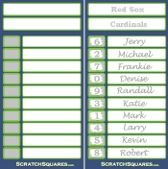Scoring Your March Madness Bracket
How do you score the rounds for the March Madness Office Pool?
We wanted to touch on how to keep score of your College Basketball Bracket and also go over what we feel are the best bracket scoring structures. First off, there is no universal way to score the bracket. There are many different point structures that can be used, but the overall set up for each is basically the same.Points Per Round
There are 6 rounds to the NCAA tournament, for each correct winner picked, a player is awarded points based on what round the winner is picked in. In most cases, and the way I feel it should be, the points per round increase as the tournament progresses. I have seen pools ran that award 1 point for every game picked correctly no matter which round it is. The chart below shows possible scoring by round systems, if you read further down the page we explain which system we think works best. Check out our Fillable Bracket and our Excel Bracket, which allow you to completely customize your bracket before printing. This includes filling in the points per round, giving your bracket a title, and typing in any notes/rules you want to pass on to the participants.
Sample Scoring Systems |
|||||
| RND 1 | RND 2 | RND 3 | RND 4 | RND 5 | RND 6 |
| 1 | 2 | 3 | 4 | 6 | 10 |
| 1 | 2 | 4 | 8 | 16 | 32 |
| 2 | 4 | 6 | 8 | 10 | 12 |
| 1 | 2 | 3 | 4 | 5 | 6 |
| 1 | 3 | 6 | 10 | 15 | 20 |
| 1 | 2 | 4 | 8 | 12 | 16 |
| 2 | 4 | 8 | 16 | 32 | 64 |
NCAA Point Systems used by ESPN, Yahoo, FoxSports, NCAA.com and CBS:
These are the top online Tournament Challenge sites.
| RND 1 | RND 2 | RND 3 | RND 4 | RND 5 | RND 6 | |
| ESPN | 10 | 20 | 40 | 80 | 160 | 320 |
| Yahoo | 1 | 2 | 4 | 8 | 16 | 32 |
| CBS | 1 | 2 | 4 | 8 | 16 | 32 |
| FoxSports | 1 | 2 | 4 | 8 | 16 | 32 |
| NCAA.com | 1 | 2 | 4 | 8 | 16 | 32 |
As you can see, CBS, FoxSports, NCAA.com and Yahoo all use the same scoring system and even though ESPN has higher point values they are exactly proportioned to the others (each round is 10x the amount of points). Remember the point value shown is for each game, multiply the number of games per round by the points per game/round then add all of the rounds together to come up with the Total Points Possible.
Round 1 - 32 Games
Round 2 - 16 Games
Round 3 - 8 Games
Round 4 - 4 Games
Round 5 - 2 Games
Round 6 - 1 Game
Total Points Possible for Yahoo, CBS, FoxSports and NCAA.com - 192
Total Points Possible for ESPN Tournament Challenge - 1,920
What system do we use?
Some people prefer to place a great deal of weight on picking the championship game correctly, like in the example 1,2,4,8,16,32. Which basically means the winner of the office pool must correctly pick the winner of the championship game. Others think that picking the most games correctly should weigh more on the outcome, like in the example 1,2,3,4,5,6. I definitely don't like the idea of putting all of the weight on the championship game, you are basically eliminating everyone that does not correctly guess the winner of the tournament. I do however feel that picking the winner in a field of 64(68) does have importance, so I prefer to use the first scoring method in the list above 1,2,3,4,6,10. This gives the people that correctly pick the tournament champion an advantage, but does not completely eliminate the people that didn't correctly guess the champion.
What about the play-in games?
Yes, the NCAA has really threw us for a loop with these new play in games. It wouldn't be so bad if all four of the play-in games were going to make up the 16 seed in each different region. But, the NCAA committee has decided they need to have a couple of 11 and 13 seeds participate in these play-in games instead of two of the 16 seeds. Anyway, you're still wondering how to incorporate these games into your office pool. We wrote a short article titled Do you Count the First Four Games in your College Basketball Pool. This article gives more detail on what you should do with the play-in games, but you basically have 2 options:
Option 1: Just don't count the play-in games, pick your winners based on a field of 64.
Option 2: Score the play-in games as you would any game in the first round, or you can also change your entire point system around to be 7 rounds, which could look something like 1,2,3,4,6,8,12. If you use this option, you will have to have your entries received by Tuesday morning before the first play-in game begins.
Other Scoring Methods
You can always add your own twist to the office pool. Some people award bonus points for upsets picked in the first round. If a player correctly picks a lower seed to beat a higher seed, they are awarded double the points for that game.You could also try a "multiplier pool", where each game you pick correctly, the "seed" number is multiplied by the points in that round.
Example using the 1,2,3,4,6,10 system:
A #1 seed pick in the first round is worth 1 point, a #15 seed would be worth 15 points.
A #1 seed in the 6th round is worth 10 points, a #2 seed would be worth 20 points.
Our new Fillable Bracket allows you to type in the points by round and then print the bracket, no more handwriting on the bracket!
If you need help filling out your brackets check out our Strategy for Winning your March Madness Pool to ensure your best chances of winning your office pool.
Scoring on the Bracket
Some folks may get confused with how to actually score the bracket. Let's use the first round as an example. Each person has picked 32 teams to win their first round game by writing each team's name in the second round of the bracket. Simply circle each team that was picked correctly and draw an "x" or a line through the incorrect games. To score the first round, you will actually be circling the names on the second round of the bracket. You do not circle the teams that are pre-entered in the round of 64. Each circle would be worth the corresponding points per round.



